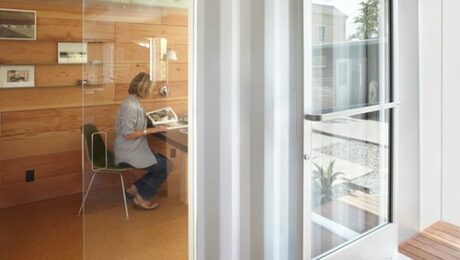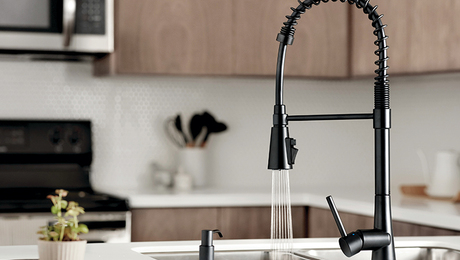Compatibility of Minisplits and Smart Thermostats
Recent discussion on Remote Control for MiniSplits got me thinking about whether “smart” T-stats (remote or not) are even compatible with MiniSplit Systems. These systems claim to adjust the HVAC based on whether or not they sense motion (ie occupancy).
1. With a mini-split, isn’t it supposed to be more efficient to let it run 24/7 at the same temp, rather than allowing it to idle, then needing to ramp up at a certain time?
2. At what duration of vacancy does it make sense to let the system idle or to change the setpoint to something less comfortable?
– Previous reading here indicates day/night programming & setback for a mini split may not be efficient. OK.
– If one day setbacks are inefficient, how many days does the place need to be unoccupied for it to be efficient to invoke setbacks? If you are gone for a week, surely you could let the house get to an uncomfortable 85 in the summer; 60 in the winter, and let the system ramp back up shortly before or upon your return? Or is this still inefficient?
3. Even if you don’t invoke setbacks at regular day/night occupancy, does it make sense to allow the HVAC to run while the doors are open? I get that it makes sense to dehumidify, but as someone with a separate dehumidifier that runs on humidity alone, I cringe whenever I see the outside unit for the minisplit ramp up while the doors are open with screens closed to “get some fresh air” (and yes, I have an ERV for fresh air, but try explaining that to a non building science person). I’m tempted to try to get my t-stat connected to my smart home system so that I can write a rule for the HVAC to stay off while the doors are open…but maybe the HVAC running to maintain temp for a few hours is more efficient than running at full ramp up once the doors are closed?
Some definitions for the discussion
1. Lets define “Remote” as the ability to view and revise the temp settings when NOT in the house (ie from a remote location). This is different than merely being able to walk around your house with a wireless controller that may use IR, Redlink or another short range protocol to communicate with a nearby receiver wired to the mini split.
2. Lets define “Smart T-stats” as those with internal ability to automatically adjust the system temperature based on occupancy, or other algorithms, without connection to any system other than the HVAC.
3. Lets define a third category as “Smart Home connectable” as t-stats that can be connected to smart home systems and allow the USER to program the HVAC system operation based on parameter data in the smart home system that goes beyond what a smart t-stat would do (such as if x door is open for more than 5 continuous minutes, turn off conditioned air at y zone).
GBA Detail Library
A collection of one thousand construction details organized by climate and house part









Replies
I think the answers to 1 and 2 are: It depends! This isn't a discussion exclusive to mini-splits, but any equipment that modulates and runs more efficient at lower output. It'll be hard for anyone to propose a definitive answer here but experiment and report back. Generally, I think we can all agree that longer durations OFF will decrease energy usage, but what the crossover point is will be different depending on installation and difficult to nail down.
Occupancy based control (marketed as "smart") are often incorporated into ductless heads, so it seems like the manufacturers see some value in it, even if it's just financial.
Why are setbacks less efficient with VRF systems? I can kinda see two arguments, both based around running at maximum output (I'm assuming a set back means that they then have to run at maximum output for a period)
1. There is a bigger efficiency penalty running at max output than with single stage equipment (ie VRF systems are less efficient in terms of BTUs per unit energy at the top of their range, so a lower COP number). Is this even true?
2. The units tend to be better sized for the load (ie less oversized) than non-VRF equipment. This means that they don't have the max capacity to quickly change the temperature after a setback. This is either a comfort argument (they can't do it quickly enough), or it's a version of number 1 (the COP is lower when running at max output).
Or am I missing something obvious?
Thanks for the links below, as usual :) Dana summarizes it well: https://www.greenbuildingadvisor.com/question/are-setbacks-always-less-efficient-with-mini-split-heat-pumps#comment-155685
They generally are less efficient at max output, although the size of the effect varies for different equipment (and is likely less than in the past?) and in different temp ranges.
The equipment should log its COP constantly and we could actually know the answer to these questions. Research could “query the fleet” as Tesla does with their cars.
I recently set up an Ecobee in my house, and part of the setup process was telling it how many zones I have, how much equipment was attached, whether I'd be simultaneously heating & cooling, and more. There are several open connection ports for ERV and fresh-air systems, in addition to the standard cluster of wires from my heat pump. So I would say "yes" in so much as they're intended to.
Getting your particular system to work with a particular thermostat is something you'll have to work out by reading manuals and chatting online, but you are certainly not the first person to face such a 21st century problem.
Ecobee has a mobile app and I can definitely switch the system on and off when I'm not at home. It also came with one additional sensor, and you can buy more, making it pretty straightforward to map the zones of your house.
Former editor Brian Pontolilo did some reporting on smart thermostats that might be of interest: How Smart Thermostats Help You Save Energy.
Thanks Kiley. Certainly smart t-stats CAN help save energy. They did for me in a residence with a traditional HVAC system.
The question is, are they appropriate for Mini Split systems that modulate, unlike traditional systems. There is another article somewhere on this site describing how setbacks (which is essentially what Smart t-stats accomplish) are not appropriate for mini splits.
CL,
Here are a few discussions that may be useful:
https://www.greenbuildingadvisor.com/article/bruce-harleys-minisplit-tips
https://www.greenbuildingadvisor.com/article/rules-of-thumb-for-ductless-minisplits
https://www.greenbuildingadvisor.com/question/are-setbacks-always-less-efficient-with-mini-split-heat-pumps
https://www.greenbuildingadvisor.com/question/minisplit-leave-it-on-or-turn-it-off
Malcom - this is an excellent list. THANK YOU!
In re-reading some of those threads, I remember reading them before, but at the time I was reading them I had far less understanding/familiarity with what I was reading.
Per the advice on another thread, I've ordered a Honeywell device that theoretically should give me access to my t-stats via the web via the Honeywell site (if this method works, it will be $100's less than the Kumo Cloud method!).
Also if this method works, I will experiment with 1 and 2 degree setbacks, and report back here.
Be wary of a 'smart' stat, it's my understanding that for most units the only stats that can modulate the equipment is the proprietary stat.
3) Don't run the AC when the door is open, unless it's only for a few minutes.
1,2) A modulating heat pump is more efficient at low load, but it's also more efficient at higher outside temperatures. What to do when the night time temperature is 30+ degrees colder than the daytime temp? I turn it down to 62F at night, then ramp it up slowly (~1 deg/hr) in the morning.
@Brad - Agree with only using the 'stat that comes with the equipment. I'm actually not aware of a smart 'stat for minisplits. But it is possible to connect some of the 'stats that come with the equipment to a home automation system, and then automate certain things, such as turning off the mini split when the door is open.
Can you share how you ramp yours up? Do you do it manually or is it connected to a home automation system? If you are only ramping up 1 degree an hour, sounds like it takes you 6 hours to get to 68 in winter, is that correct?
I have an american std system and the thermostat has scheduling capability. We just turn it up to 64 automatically, & often just let the sun warm it up the rest of the way. If the sun isn't doing it I'll manually turn it up. The sun will usually warm our house up to 68 or 70. I have a unique wife who doesn't need it super warm in the house :)
These heatpump systems are great, but the controls are lacking. The big issue with the Nest and Ecobee line is they don't send the target temp to the indoor unit, so it can't compute Delta-T properly.
Also, they don't send ambient temp to the units either, so the indoor units use their own intake temperature sensors as the basis of indoor room temp, which can be way off for a number of reasons. This is a bigger issue than the Delta-T issue in my opinion, particularly if it's one of the larger air handlers more distant from the rooms where the thermostat is.
In our new home, we have settled for using the MHK1 stats that came with the units (they are modified Honeywell units), and then installed 2nd gen kumo adapters so I can program them from an app much more easily than the wall units which are awful to program, esp if you have a lot of zones), and Kumo's interface to smart home automation systems so they can have the same features around occupancy etc... the smart stats have.
I wish Nest etc... would make units that plug into these units natively. At least for Mitsubishi units, the thermostats interface via the CN105 jack, which is just a serial port, and is easily interfaced to.
Mike - can you elaborate on why you chose to go with the Kumo Cloud method vs linking the MHK1 stats to the Honeywell Total Connect Comfort? Are you MHK1's connected to a traditional heat pump or a minisplit?
Also, what Kumo interface do you have to smart home automation? And which automations do you use?
My plan is to see if I can connect the MRCH1's I have to the Honeywell Total Connect via a single Redlink internet gateway, then link Total Connect to the smart home system, and then use the smart home system to adjust step the setbacks up gradually by one degree.